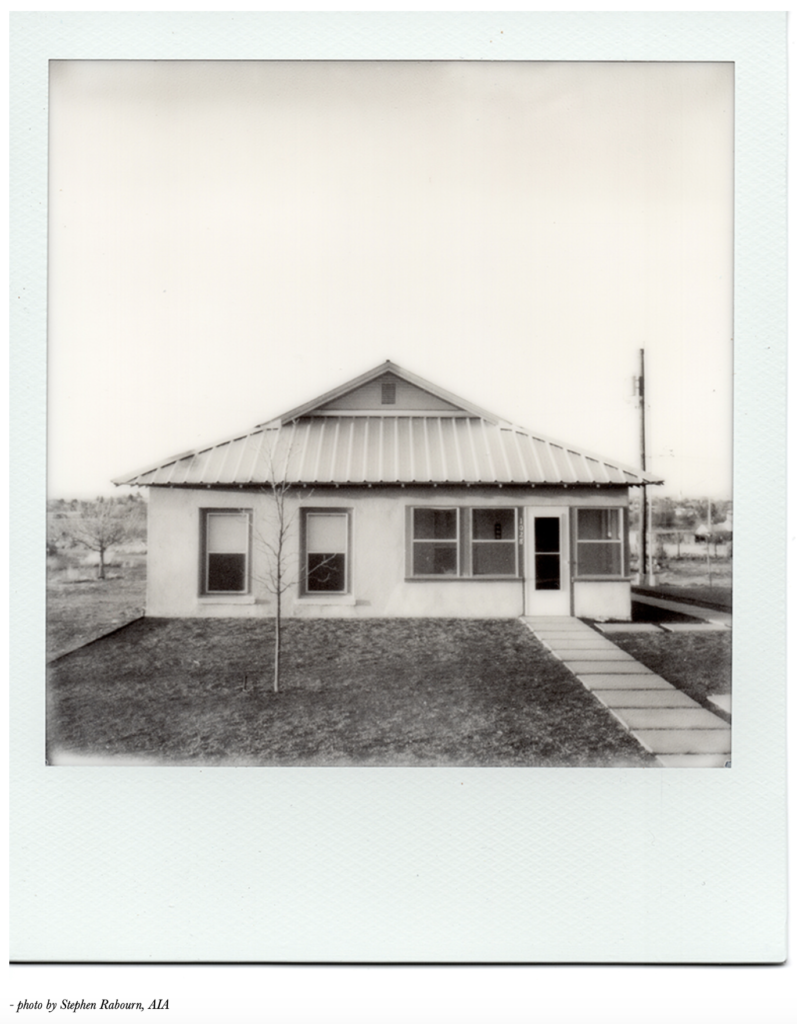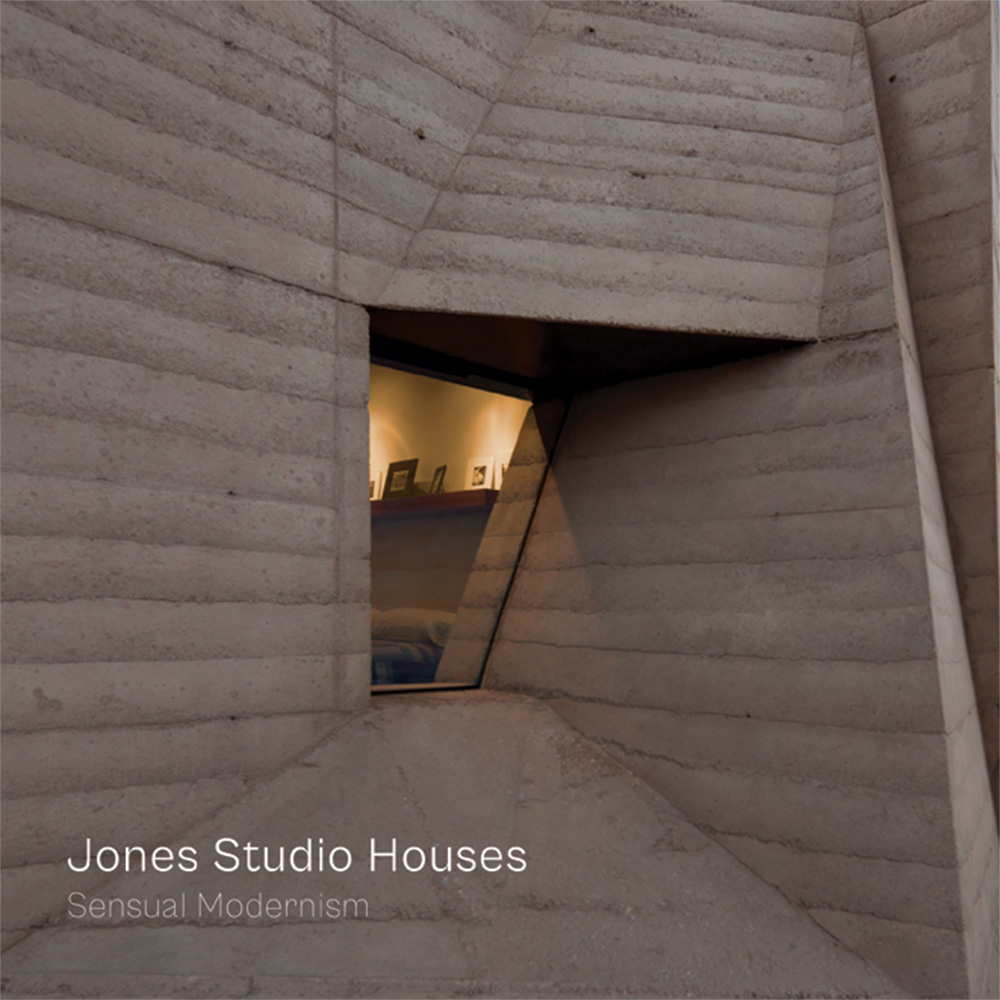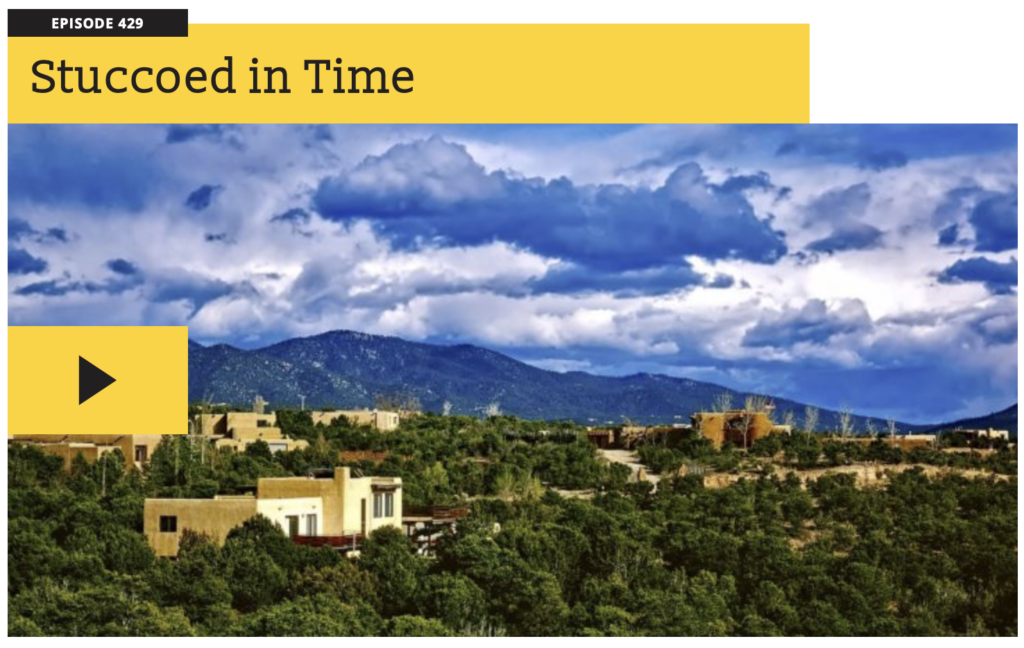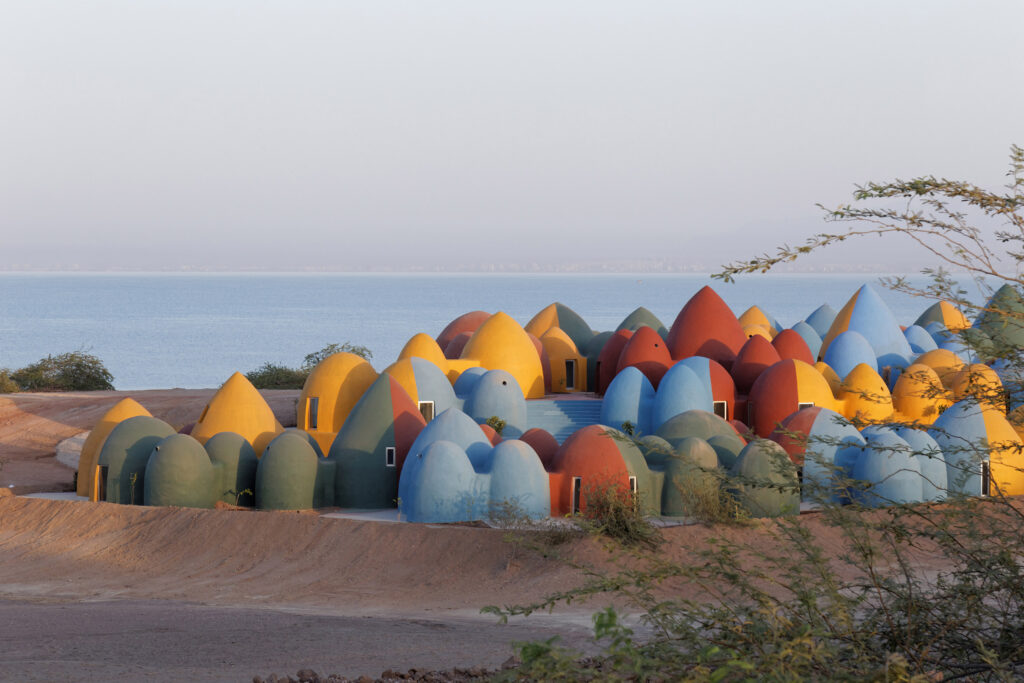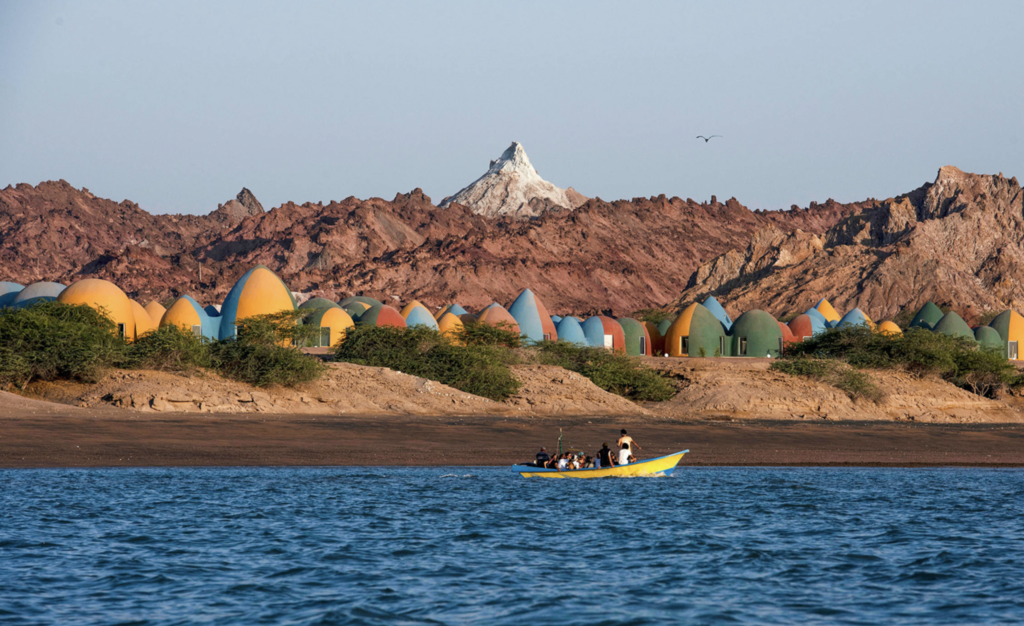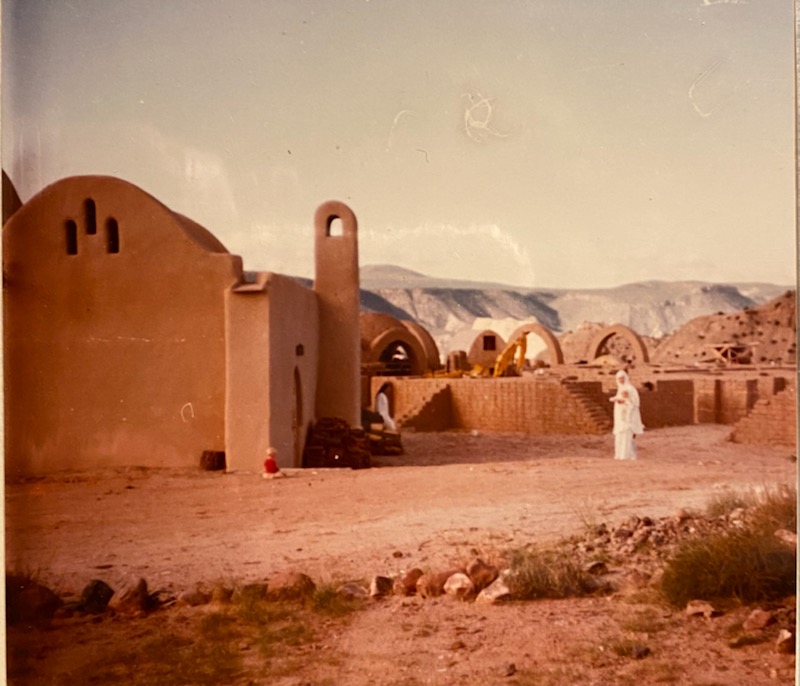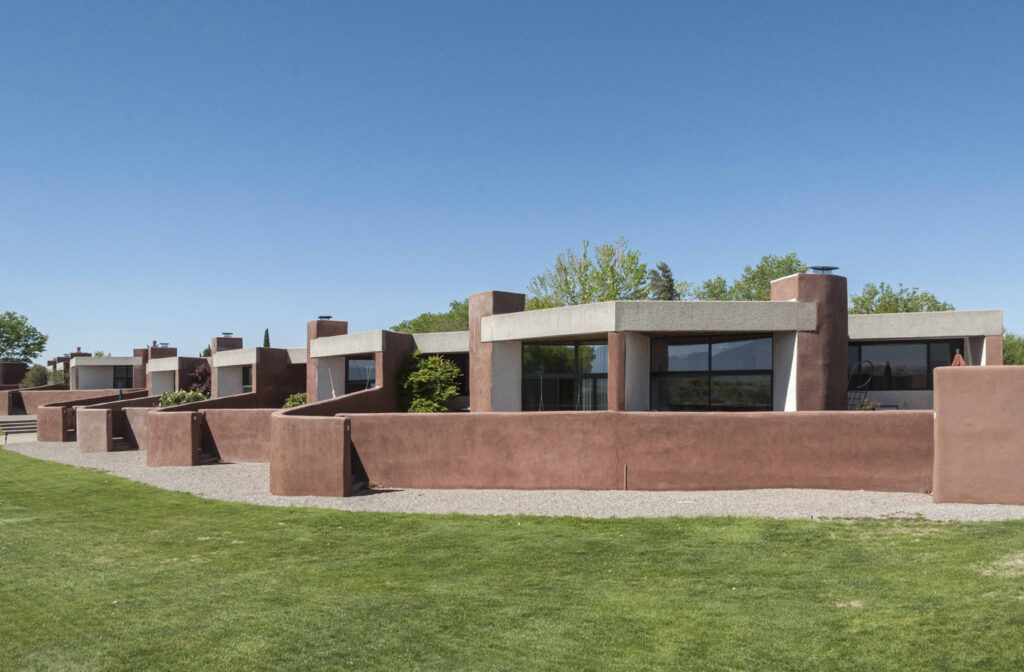
La Luz, designed by Antoine Predock, is a planned townhouse community that blends modern architecture with materials that reflect the cultural heritage and traditional building practices of the southwest region. Located in Albuquerque, New Mexico, on open land between the Rio Grande and the Sandia Mountains, La Luz was conceived by Predock in 1967 and completed by 1974.
The development features 96 townhomes, ranging from 1,500 to 2,100 square feet, clustered together with 16-inch thick adobe walls. This design choice not only pays homage to traditional Southwestern architecture but also serves a functional purpose by providing excellent thermal mass for passive climate control.
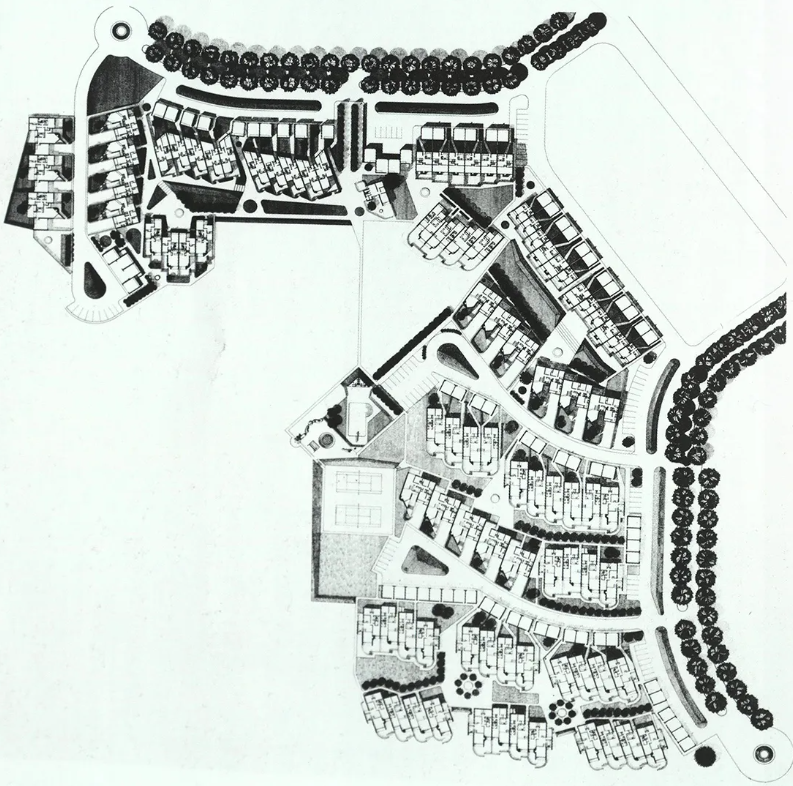
The townhouses in La Luz’s layout are oriented eastward, offering residents picturesque views of the Sandia Mountains and morning sun, while the western facade features mostly blank walls to shield against harsh afternoon sun and dust storms. Private courtyards act as solar traps in winter and provide shade in summer.
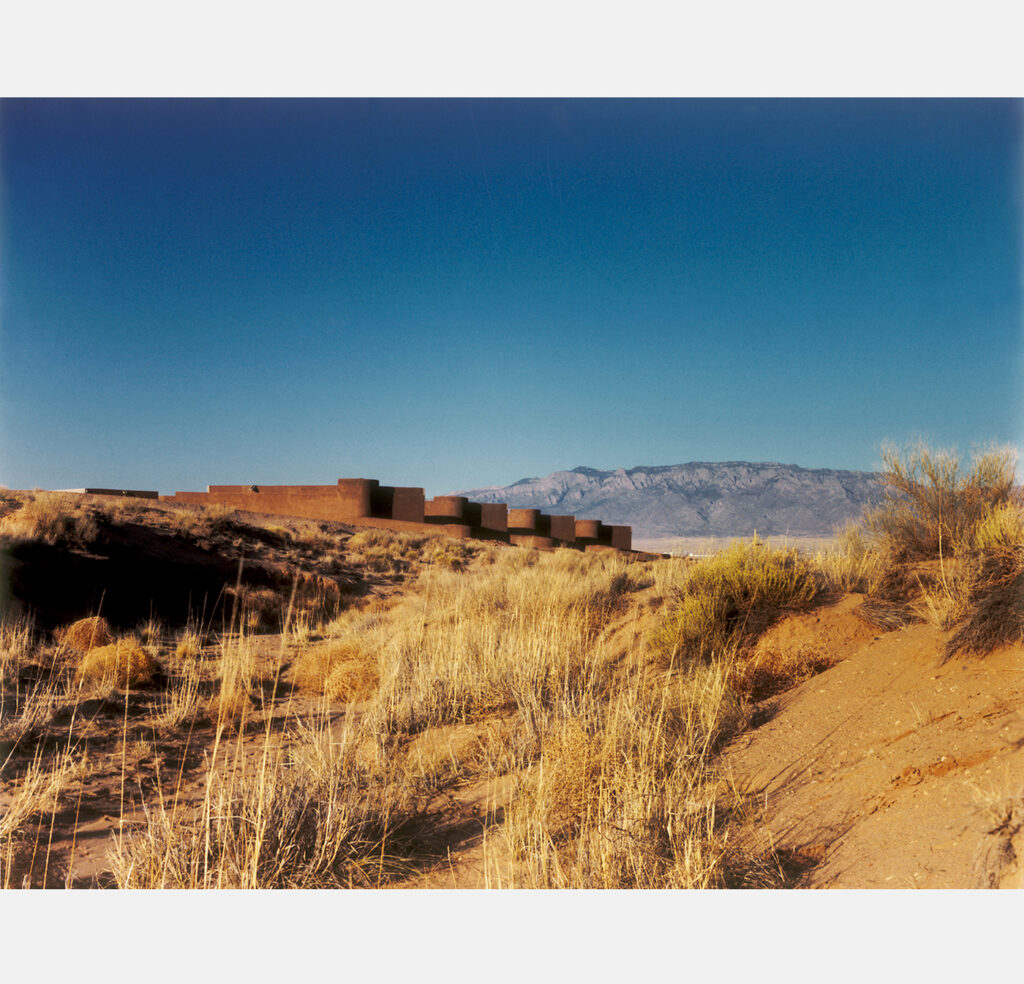
The site design is inspired by the architectural heritage of Native pueblos and Hispanic villages in New Mexico and is accentuated with curved walls, which soften the overall aesthetic and mirror the natural contours of the landscape.
The development contributes to a sense of community through the inclusion of shared green space, fountains, pedestrian paths, tennis courts, and a swimming pool. La Luz also preserves 40 acres of untouched land as a permanent natural preserve.
La Luz, with its adobe-inspired design, became the cornerstone that cast Predock into the national spotlight and lay the foundation for the recognition he received in the American architectural field.
Despite not being a native of New Mexico, Predock considered Albuquerque his spiritual home and the place that shaped his architectural vision.
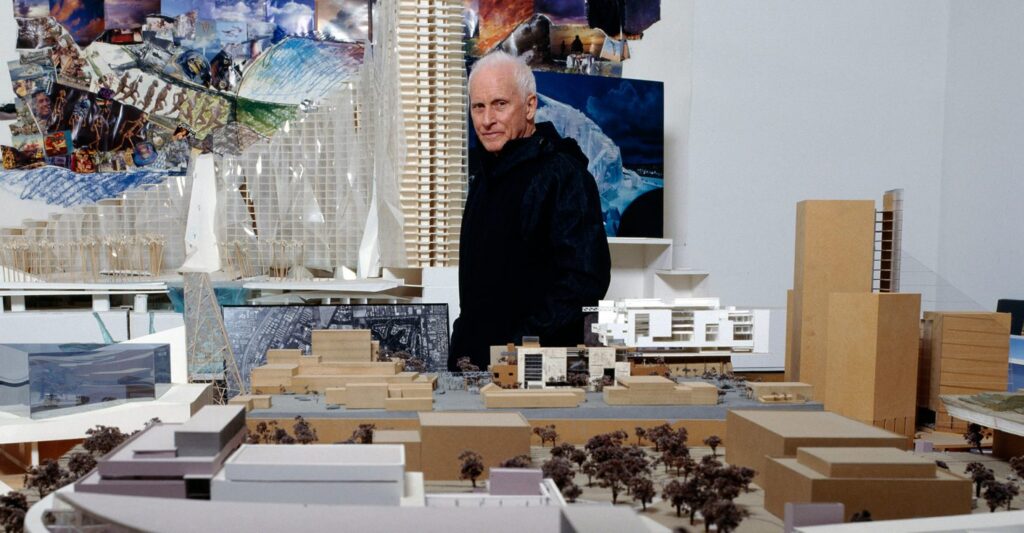
Born on June 24, 1936, in Lebanon, Missouri, Predock’s architectural journey began while taking a technical drawing course taught by Professor Don Schlegel during his time as an engineering student at the University of New Mexico. This experience compelled Predock to transfer to Columbia University to pursue his B.A. in architecture, which he received in 1962.
After graduation, Predock was awarded a traveling fellowship that allowed him to explore Spain, Portugal, and other parts of Europe for two years. After apprenticing, he established his own architectural firm, La Luz was one of the firm’s early projects that highlighted his unique approach toward weaving modernism with the regional traditions of the American southwest.
CITATIONS:
[1] Predock, A. (n.d.). La Luz. Antoine Predock Architect PC. Retrieved from http://www.predock.com/LaLuz/La%20Luz.html
[2] Predock, A. (n.d.). Desert Beginnings. Antoine Predock Architect PC. Retrieved from http://www.predock.com/DesertBeginnings/desertbeginnings.html
[3] Pearson, C. A. (2024, March 4). Tribute: Antoine Predock (1936–2024). Architectural Record. Retrieved from https://www.architecturalrecord.com/articles/16768-tribute-antoine-predock-19362024
[4] Albuquerque Modernism. (n.d.). La Luz Community. University of New Mexico. Retrieved from https://albuquerquemodernism.unm.edu/posts/cs13_la_luz.html
[5] Wilson, C. (2014). La Luz Community. SAH Archipedia. Retrieved from https://sah-archipedia.org/buildings/NM-01-001-0007
[6] Lucas, C. (n.d.). Architect Antoine Predock’s La Luz Community. Chris Lucas ABQ. Retrieved from https://www.chrislucasabq.com/post/flyer-architect-antoine-predocks-la-luz-community-5-tennis-court-nw-87120
[7] Docomomo US. (2022, July 14). The Planned Community of La Luz is Listed on the National Register of Historic Places. Retrieved from https://www.docomomo-us.org/news/the-planned-community-of-la-luz-is-listed-on-the-national-register-of-historic-places
[8] AIA Los Angeles. (n.d.). Antoine Predock, FAIA. Retrieved from https://aiala.com/antoine-predock-faia/
[9] World-Architects. (2024, March 4). Antoine Predock, 1936-2024. Retrieved from https://www.world-architects.com/en/architecture-news/headlines/antoine-predock-1936-2024
[10] American Academy in Rome. (2024, March 6). In Memoriam: Antoine Predock. Retrieved from https://www.aarome.org/news/features/memoriam-antoine-predock
The McDonald Ranch House
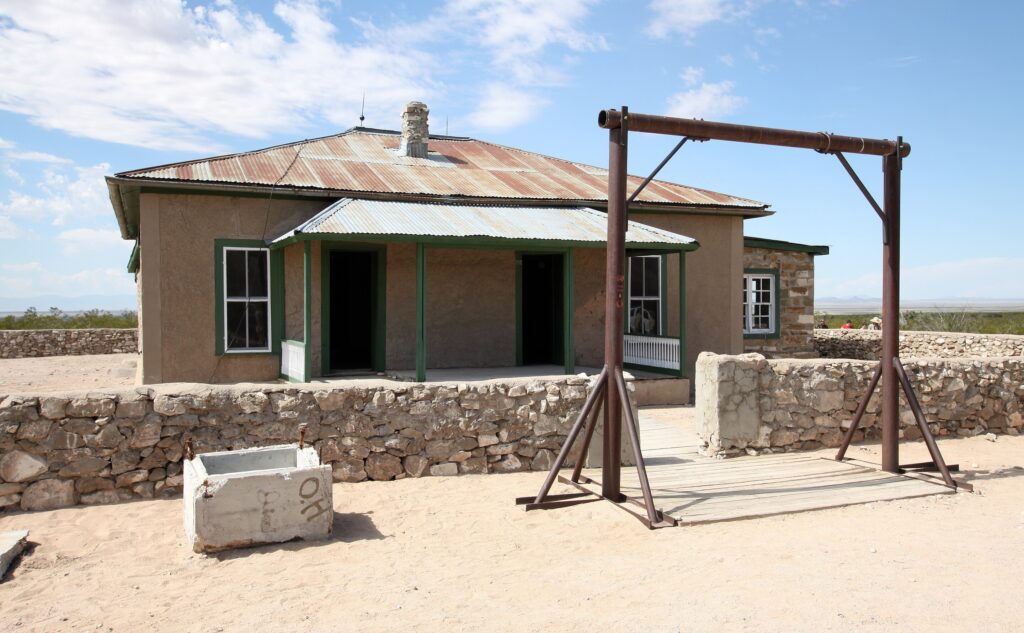
The McDonald Ranch House in the Oscura Mountains of Socorro County, New Mexico, was the location of assembly of the world’s first nuclear weapon. The active components of the Trinity test “gadget”, a plutonium Fat Man-type bomb similar to that later dropped on Nagasaki, Japan, were assembled there on July 13, 1945. The completed bomb was winched up the test tower the following day and detonated on July 16, 1945, as the Trinity nuclear test.
The George McDonald Ranch House sits within an 85-by-85-foot (26 by 26 m) low stone wall. The house was built in 1913 by Franz Schmidt and is built of adobe, which was plastered and painted. The plutonium hemispheres for the pit of the Trinity nuclear test “gadget” (bomb) were delivered to the McDonald Ranch House on July 11, 1945. Text via Wikipedia.
Mud is not the Villain
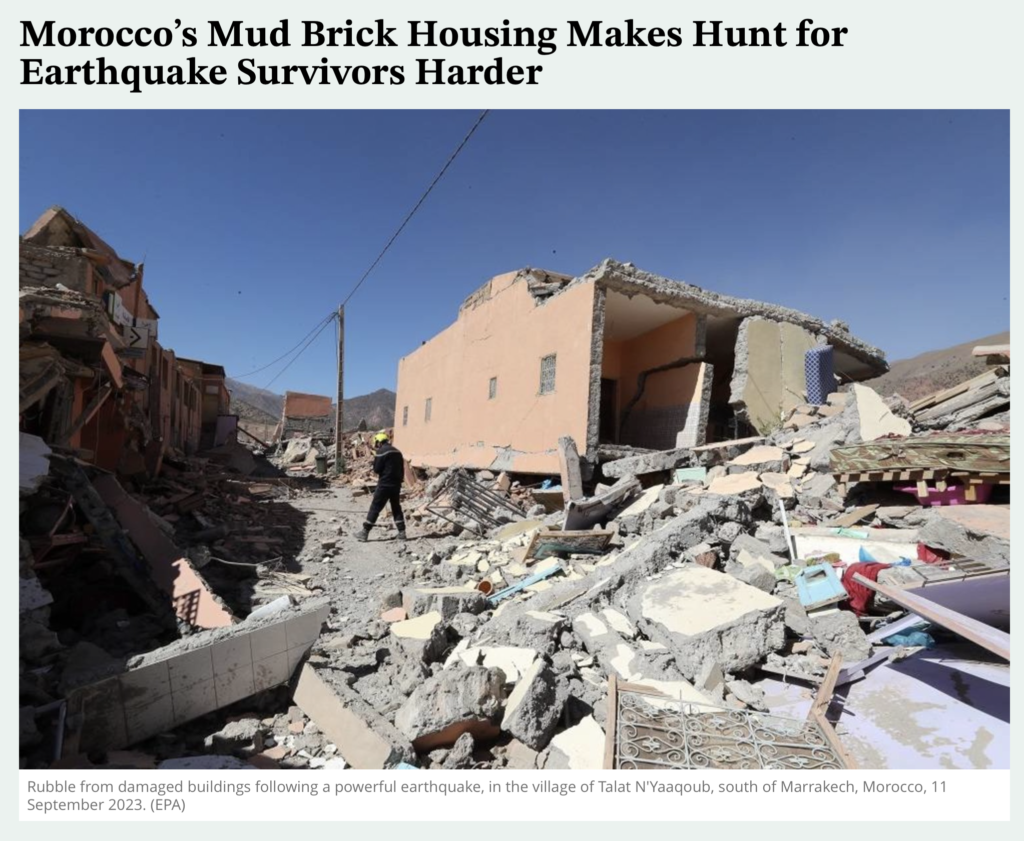
Morocco recently experienced the most devastating earthquake that the country has had in the last 60 years. To date, more than 2,600 people have died and news outlets are quick to point out that the cause of death isn’t the earthquake, but the buildings made of earth. While I am aware of the thousands of mud brick and rammed earth buildings that define the villages in the Atlas Mountains where the disaster took place, I note that the photos of the devastation often show buildings made of reinforced concrete or concrete masonry units. The tendency to villainize earthen architecture traditions is a common practice. The headline of one article reads, “Morocco’s Mud Brick Housing Makes Hunt for Earthquake Survivors Harder” and yet the cover image is clearly of a reinforced concrete building. As I scroll through articles about the earthquake, I do see many earthen buildings that have been damaged, but I also see a large number of buildings constructed of industrially produced materials. In the 1995 earthquake in Kobe, Japan, three times the number of people died, and over 100,000 buildings were destroyed in a city that was largely constructed of concrete and steel. Kobe was a magnitude 6.9 earthquake similar to Morocco’s 6.8. The 6.9 Loma Prieta earthquake in the San Francisco Bay Area caused an estimated $14 billion in damage to buildings, bridges, and highways with the majority of deaths happening under reinforced concrete structures like the Cyprus Street Viaduct.
The New York Times writes, “Mud brick buildings common to the region — some of which date back to before Morocco’s colonization by the French — were reduced to a collapsed sand castle.” France colonized Morocco in 1912, making many of the buildings older than 111 years old It should be pointed out that the seismic activity of these regions is high, and earthen building traditions have survived in seismic zones for thousands of years. The oldest buildings in every seismic zone are constructed of earth, including those found in the San Francisco Bay Area. A visit to downtown Sonoma, the Missions, the Petaluma Adobe, and countless other mud brick buildings demonstrate the longevity of earthen architecture in earthquake-prone regions. A visit to Santiago, Chile, a city with a history of earthquakes, will also demonstrate how earthen architecture has survived in many urban and rural environments while adapting to a ground that shakes.
Yes, buildings made of mud brick and rammed earth did collapse causing many deaths. However, reinforced concrete and concrete masonry units did as well — there simply happens to be more earthen buildings in that region, just as there are more reinforced concrete buildings in Kobe, Japan. And despite the reality that our continued quest to combat the forces of mother nature, we continue to find that she wins. But perhaps she is not the villain, nor is architecture made of earth. According to Bloomberg, man-made climate-related disasters due to climate change account are linked to approximately 5 million deaths per year and the concrete industry is responsible for about 8% of planet-warming carbon dioxide emissions. Earthquakes account for approximately 60,000 of those deaths, however, few of those are related to the collapse of earthen buildings. Some of those deaths are related to the collapse of buildings made with other materials, landslides, and tsunamis. Some earthquakes are a product of fracking and mining.
I do not believe that earth architecture is the villain in the tragedy in Morocco. Rather, it is the cultural perception of the building material, and the prejudices against those that live in them, within a capitalist society. Earth is an inherently ecological material, possesses excellent thermal mass properties, requires little embodied energy, and is recyclable—earth buildings can return to Earth. It should be noted that most of the recent Pritzker Prize winner Francis Kere’s buildings are constructed of mud, and as I wrote about in my book, Earth Architecture, a number of universities including the Pontificia Universidad Católica del Perú, the University of Kassel, Germany, and the University of Technology, Sydney are advancing the technology of creating earthquake-resistant earth buildings. Let us look to solving the 5 million deaths per year due to climate change, and improve the technologies of earthen construction as humans have continued to do for the past 10,000 years of civilization before we eradicate large percentages of the population due to industrialized building practices that have not proven to safely house the planet, unlike our planetary traditions of earthen architecture.
The Adobe Factory
The Adobe Factory in Alcalde, New Mexico, is the largest adobe factory in the world, with the capability of producing up to 25,000 adobes each day. Here’s how it is done:
The Adobe Paradox
Once a building material of the humble economy used by autochthonous peoples of the Southwest, adobe has become fashionable among Marfa’s affluent newcomers. Here, in this article in Texas Architect, a student with roots in the town’s Mexican-American community and and architect practicing in the region discuss the building block’s complex cultural content. Because, in a Texas Art Mecca, Humble Adobe Now Carries a High Cost, according to this New York Times article discussing how taxes are higher for adobe homes.
JONES STUDIO HOUSES: Sensual Modernism
Jones Studio Homes: Sensual Modernism is a self-imposed limited look at the 40-year-plus career of Eddie Jones. Almost unheard of outside the southwest United States, Jones has quietly accumulated a body of work ranging beyond residential design to include major federal projects impacting the edges of America… to be featured in a soon to be published monograph!
Supported by Aaron Betsky’s insightful forward, plus an enlightening interview with Vladimir Belogolovsky, and comments from many of his famous colleagues, Jones summarizes his lifelong dance with architecture through the personal stories embedded in each house. Refusing to repeat himself, the work tests the reality of gravity on a diverse spectrum of interpretive vernacular responses to climate, landscape and function. Although designed by the same hand, the forms vary as much as the choice of materials. Rammed earth, concrete, wood and metal are explored together and separately yet remain subordinate to Jones’ fascination with glass.
Utilizing photographs, hand-drawings and first-person accounts, the motivations and joy of being an architect are expressed by an exceptional whole informed by many ordinary parts.
Stuccoed in Time at 99% Invisible
Santa Fe is famous in part for a particular architectural style, an adobe look that’s known as Pueblo Revival. This aesthetic combines elements of indigenous pueblo architecture and New Mexico’s old Spanish missions, resulting in mostly low, brown buildings with smooth edges. Buildings in the city’s historic districts have to follow a number of design guidelines so that they conform with the dominant style. Deviating from those aesthetics can stir up a lot of controversy.
But this adherence to the “Santa Fe Style” hasn’t always been the norm. For a time, there was actually a powerful push to “Americanize” the city’s built environment. Then, over a century ago, a group of preservationists laid out a vision for the look and feel of Santa Fe architecture, and in the process dramatically transformed the town.
Majara Residence
Iranian practice ZAV Architects drew on the colourful landscape of the island of Hormuz for this holiday community that is housed in around 200 brightly colored domes overlooking the Persian Gulf.
The project is a multitude of small-scale domes built with the superadobe technique of Nader Khalili, the innovative and simple technique using earth and sand packed into bags. Domes are familiar structures in the region. Their small scale makes them compatible with the building capabilities of local craftsmen and unskilled workers, which have been prepared for this project with previous smaller projects. Today they are trained master superadobe masons, as if Nader Khalili multiplied exponentially.
H2OS
The H2OS project, or Open Source Prototype House for Eco-Villages in Senegal, is a prototype house constructed of compressed earth block, that can harvest and store water supplies for all domestic uses (drinking, cooking, washing, irrigation) and to integrate the scarce water resources in a few artificial walls. The project relies on ancient knowledge such as how to harvest rain water or how to ventilate rooms while incorporating up to date technologies for energy production from renewable sources. Learn more here.
The Mud Episode from the Santa Fe Art Institute
Listen to the mud episode of Unsettled podcast from Santa Fe Art Institute created by Dr. Alicia Inez Guzmán & Diego Medina. Listen to artists Joanna Keane Lopez and Christine Howard Sandoval reflect on the the complex history, traditions, politics, and meanings embedded within the act of building with mud in New Mexico and California.

